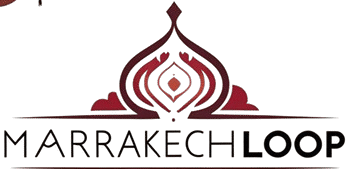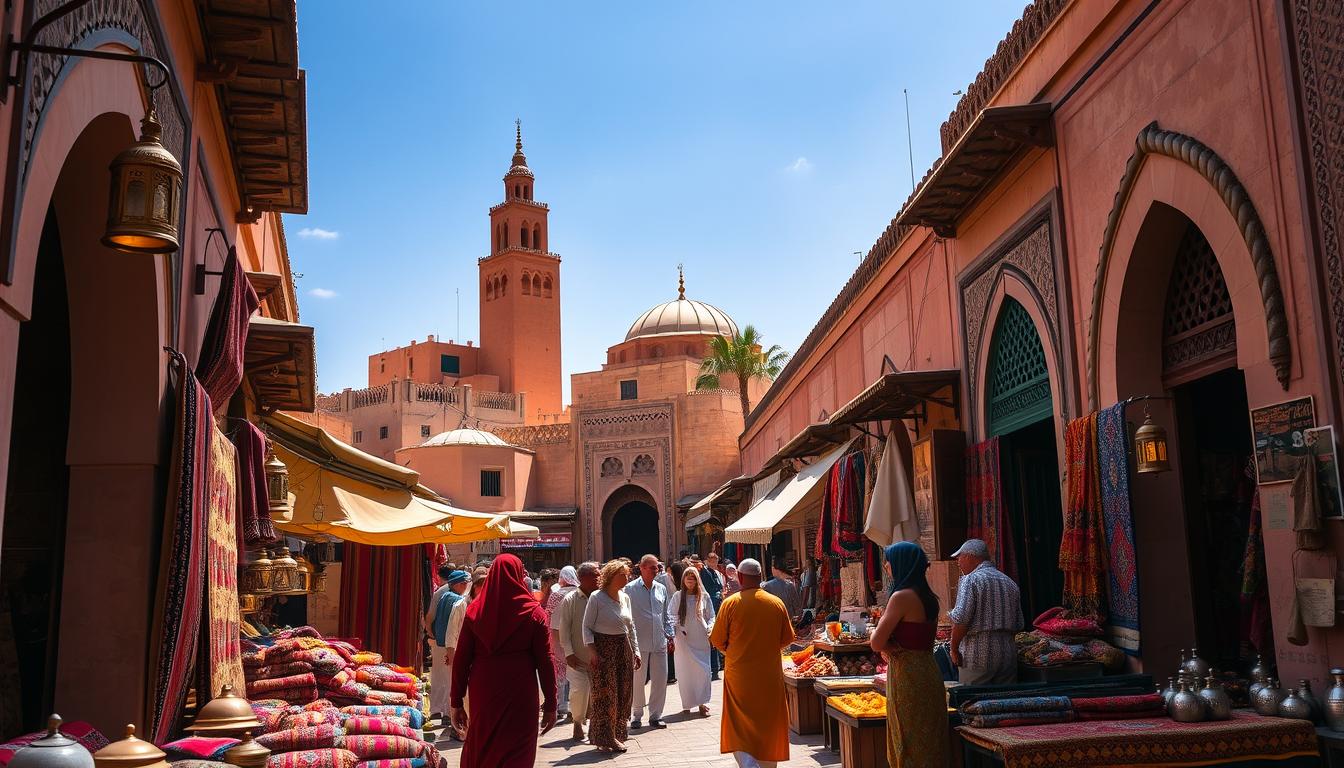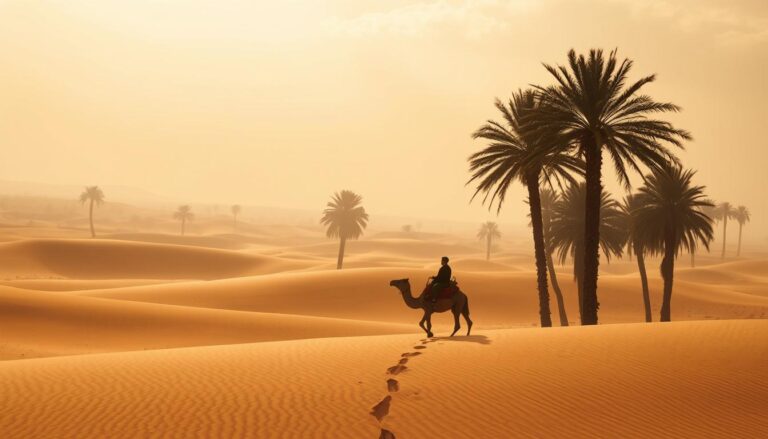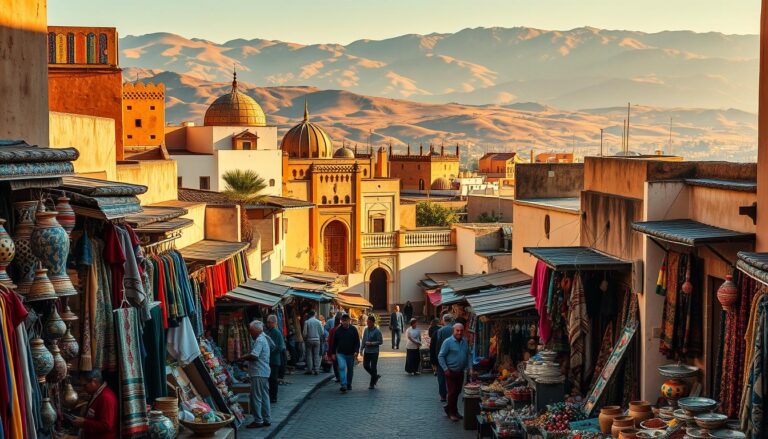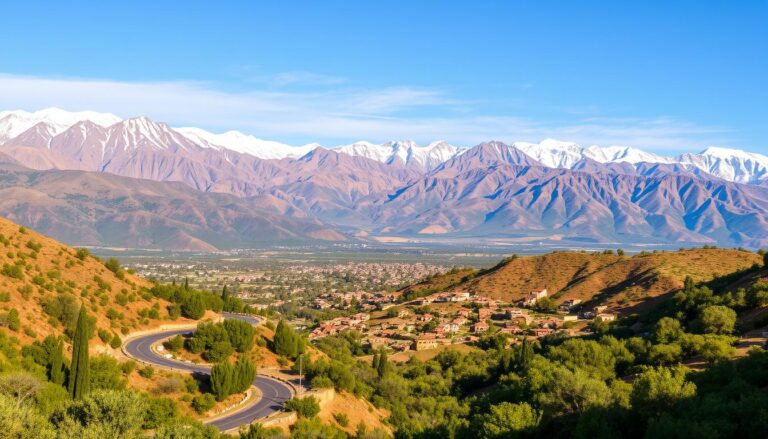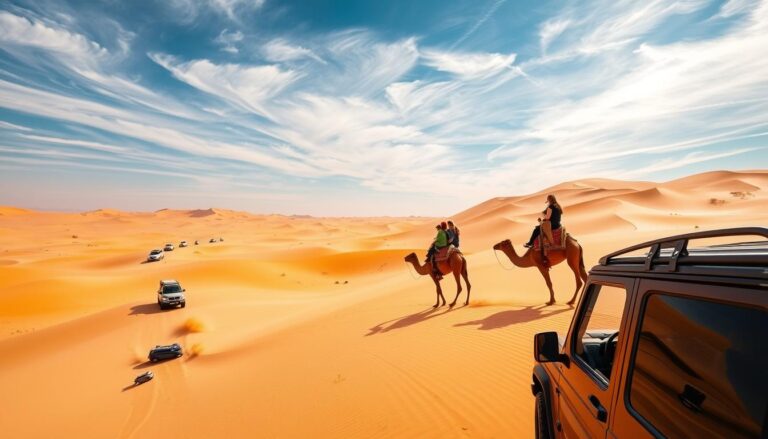Explore the Vibrant Moroccan Culture
As you step into the vibrant world of Moroccan culture, you’re immediately enveloped in a rich tapestry of traditions, colors, and aromas.
From the bustling souks of Marrakech to the serene landscapes of the Atlas Mountains, Morocco is a country that seamlessly blends the ancient with the modern.
In this article, we’ll take you on a journey through the various facets of this fascinating country. We’ll provide you with a deeper understanding and appreciation. Whether you’re planning a trip to Marrakech or simply interested in learning more, this guide is your starting point. You might be wondering what to pack for Marrakech; we’ll get to that later, including your Marrakech packing list.
Key Takeaways
- Discover the rich history and traditions of Morocco
- Learn about the cultural significance of Marrakech
- Understand the importance of packing appropriately for Marrakech
- Explore the blend of ancient and modern Moroccan Culture
- Get insights into the vibrant souks and markets
Introduction to Moroccan Culture
The heart of Moroccan culture is its rich heritage. It’s shaped by centuries of history and cultural exchanges. You’ll see this mix in the country’s buildings, food, and traditions.
Exploring Moroccan culture makes your trip better. Whether you’re in Marrakech’s markets or talking to locals. Knowing what to pack for Marrakech helps a lot. It’s not just clothes; it’s about getting into the local way of life.
- The importance of traditional clothing and textiles
- The role of cuisine in bringing people together
- The importance of respecting local customs and traditions
When you’re getting ready for your trip, remember to pack more than clothes. Bring an open mind and a desire to learn the local culture. This attitude will make your trip unforgettable and let you see the beauty of Moroccan culture.
The Rich History of Morocco
Morocco’s history is a mix of many cultures, each leaving its mark. Exploring this country, you’ll see how cultures have shaped its identity.
Ancient Civilizations and Influences
The Berbers were among the first to influence Morocco, creating a rich culture. Then, Arab conquests brought Islam, changing Moroccan society. When you visit Marrakech, knowing this history makes landmarks more meaningful.
Carrying a guidebook or a local expert in your packing list for Marrakech can help. They offer insights into the sites you’ll see.
In the ancient medinas, you’ll see different architectural styles. This shows the impact of various cultures on Morocco. Wearing comfortable shoes, as part of your essential items for Marrakech, lets you explore without pain.
The Colonial Era’s Impact
The colonial era, especially under France, changed Morocco a lot. It brought modern things but also hurt local cultures. Knowing this history makes your trip more meaningful.
Think about the history of places you’ll visit. Morocco’s past is still alive today. This helps you understand its culture and landmarks better.
Traditional Moroccan Cuisine
Moroccan cuisine is a big part of the country’s identity. It offers a unique sensory journey. You’ll find a rich culinary heritage that shows the country’s diverse cultural influences.
Famous Dishes to Try
Moroccan food is known for its bold flavors and smells. Dishes like tagines, couscous, and pastilla highlight the country’s cooking skills. In Marrakech, make sure to try these local favorites, made with fresh ingredients and cooked just right.
Some dishes you should not miss include:
- Tagine with preserved lemons and olives
- Couscous with vegetables and meat
- Pastilla, a savory pie made with layers of flaky pastry
The Role of Spices in Moroccan Cooking
Spices, herbs, and preserved lemons make Moroccan cooking special. Common spices like cumin, coriander, cinnamon, and turmeric are often mixed to create unique tastes.
When you’re packing for your Marrakech trip, think about bringing some local spices. They’re great for trying out new recipes at home.
Moroccan Teas and Their Significance
Moroccan tea is a big part of the culture. Gunpowder green tea is a favorite in most homes. The tea is made with fresh mint leaves and sugar, making it refreshing and calming.
Visiting Marrakech? Don’t miss out on a traditional tea ceremony. It’s a must-have item for your Marrakech trip. It’s a wonderful way to experience local hospitality and learn about tea’s cultural importance in Morocco.
Festivals and Celebrations in Morocco
Morocco’s festivals are a vibrant expression of Moroccan culture. When planning your trip, try to visit during a festival. This will make your trip even more special.
Major Annual Events
Morocco has many big events every year. The Marrakech International Film Festival is a big deal. It features the best movies from Morocco and around the world.
The Essaouira Gnawa Music Festival is another must-see. It celebrates Gnawa music and culture.
These festivals are fun and give you a peek into Moroccan culture. Make sure to pack a Marrakech packing list with cultural guides or festival schedules. This will help you enjoy your time more.
Local Festivals and Traditions
Morocco also has many local festivals and traditions. These are deeply connected to the country’s history. For example, the Mawazine Festival in Rabat is a big celebration of music and culture.
Going to a local festival is a great way to see the real Morocco. Just remember to respect the local customs and traditions.
By joining in Morocco’s festivals and celebrations, you’ll learn a lot about its culture and traditions.
Moroccan Art and Craftsmanship
As you explore the vibrant souks of Morocco, you’ll find a world of detailed art and craftsmanship. The country’s rich culture shines through in its stunning art. You’ll see beautiful pottery, textiles, calligraphy, and paintings.
Traditional Crafts: Pottery and Textiles
Moroccan artisans are known for their skill in traditional crafts. Pottery, for example, has been passed down for generations. It’s often decorated with bright colors and patterns.
When in Marrakech, make sure to visit the local markets. There, you can find these unique handicrafts. It’s a good idea to wear comfortable clothes, as they are essential items for Marrakech.
Textiles in Morocco are also a big deal. They have intricate patterns and colors that tell stories of the country’s history and culture. You might want to pack some of these beautiful textiles as souvenirs or gifts.
- Handmade pottery with traditional designs
- Vibrant textiles, including rugs and clothing
- Intricately designed metalwork and jewelry
The Importance of Calligraphy and Painting
Calligraphy and painting are highly valued in Morocco. They are often used to decorate mosques, palaces, and other important buildings. Calligraphy, in particular, is seen as a sacred art, used to honor the Quran and other important texts.
When getting ready what to pack for Marrakech, don’t forget a good camera. This way, you can capture the detailed beauty of these art forms.
Moroccan paintings mix traditional techniques with modern themes. This creates a unique blend of old and new. You can find these art pieces in local galleries and markets, giving you a glimpse into Morocco’s rich artistic heritage.
- Traditional calligraphy used in religious texts
- Modern paintings that blend traditional techniques with contemporary themes
- Intricately designed illuminations in ancient manuscripts
Music and Dance in Morocco
In Morocco, music and dance are key parts of daily life. The country’s varied musical and dance traditions show its rich history. Different styles blend together beautifully.
When exploring Morocco’s music and dance, remember to respect local customs. Wearing modest clothes is a sign of respect. Also, bring earplugs or a portable charger to make your experience better. For example, if you’re going to Marrakech, add these items to your Marrakech travel essentials list.
Popular Musical Genres
Moroccan music is diverse, with genres like Gnawa, Chaabi, and Andalusian classical music being favorites. Gnawa music stands out with its lively rhythms and spiritual songs.
Here are some key characteristics of popular Moroccan musical genres:
| Genre | Description | Notable Features |
|---|---|---|
| Gnawa | Spiritual music with African roots | Energetic rhythms, healing rituals |
| Chaabi | Popular folk music | Upbeat melodies, storytelling |
| Andalusian Classical | Traditional classical music | Complex rhythms, poetic lyrics |
Traditional Dance Styles
Moroccan dance is as varied as its music, with styles like Berber and Gnawa dance being well-known. The Berber dance is known for its graceful movements, showcasing Berber culture.
When watching or joining in traditional dances, always respect local customs. Dressing modestly and being mindful of your surroundings is important. If you’re going to Marrakech, packing tips for Marrakech can help you prepare for the local culture.
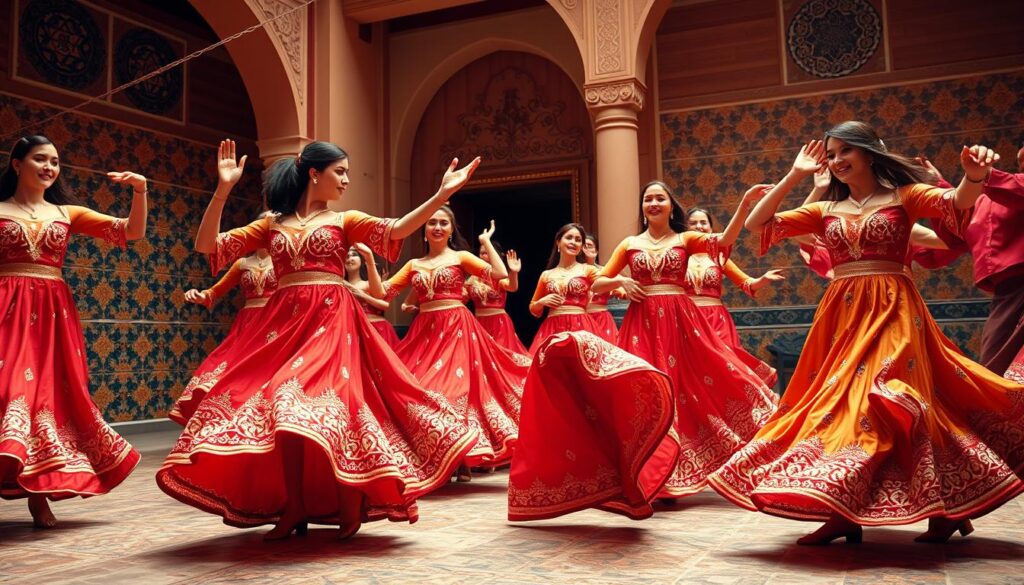
Morocco’s rich musical and dance heritage offers a unique cultural experience. By being respectful and prepared, you can fully enjoy the vibrant rhythms and elegant movements that define this beautiful country.
The Role of Religion in Moroccan Life
Exploring Morocco shows a complex mix where religion is a big part of daily life. As you learn about Moroccan culture, you’ll see Islam’s big role. It shapes the country’s identity, architecture, art, and social ways.
In Morocco, most people follow Sunni Islam. This is seen in the beautiful mosques and Islamic landmarks everywhere. When visiting these places, it’s important to respect local customs and dress modestly. This is one of the must-have items for your Marrakech trip.
Islamic Practices and Festivals
Islamic practices are a big part of Moroccan life. The call to prayer from minarets is common. The month of Ramadan is celebrated with fasting and community spirit.
Morocco also celebrates Islamic festivals like Eid al-Fitr. It’s a time of feasting and giving gifts, marking Ramadan’s end. Knowing and respecting these practices can make your experience of Moroccan culture better.
Other Religious Influences
While Islam is the main religion, Morocco has been influenced by others. The country’s Jewish heritage is still seen in places like Fez and Marrakech’s mellahs. This mix of religions makes Moroccan culture rich and diverse.
Exploring Morocco shows that religion is more than personal faith. It’s a way for people to come together. Joining in or watching these religious activities can help you connect with the community and understand Moroccan identity.
Language and Dialects in Morocco
Exploring Morocco reveals a rich mix of languages and dialects. Morocco’s linguistic diversity is a key part of its cultural heritage. Arabic and Berber (also known as Amazigh) are the official languages, each deeply rooted in the country’s identity.
Arabic and Berber Languages
Arabic is widely spoken, used in official settings, education, and media. Modern Standard Arabic is taught in schools and used formally. Moroccan Arabic (Darija) is the everyday colloquial form.
Berber is spoken by the indigenous Berber communities, with various dialects across regions. Learning basic phrases in Arabic or Berber can improve your interactions with locals. Including a phrasebook or a translation app in your Marrakech packing list is very helpful. Simple greetings like “As-salamu alaykum” (peace be upon you) in Arabic or “Azul” (hello) in Berber show respect for the Moroccan Culture.
The Role of French in Modern Moroccan Culture
French is widely used in Morocco, especially in business, education, and government. It’s a legacy from the colonial era, still used today due to historical and economic ties with France. Many Moroccans speak French as a second language, making it easier for French-speaking tourists to communicate.
When planning your trip to Morocco, think about what to pack for Marrakech. You might also consider a French phrasebook or learning basic French phrases. This is especially helpful in formal or business settings, or when talking to the educated elite.
Morocco’s language landscape is complex and diverse, showing its rich history and culture. As you explore the country, knowing about the languages and dialects can make your experience richer. It allows for deeper connections with the people and culture.
Traditional Clothing and Fashion
In Morocco, traditional clothes are a big part of everyday life. They show the nation’s spirit and the pride in heritage. When you visit the souks and talk to locals, you’ll see how important these clothes are.
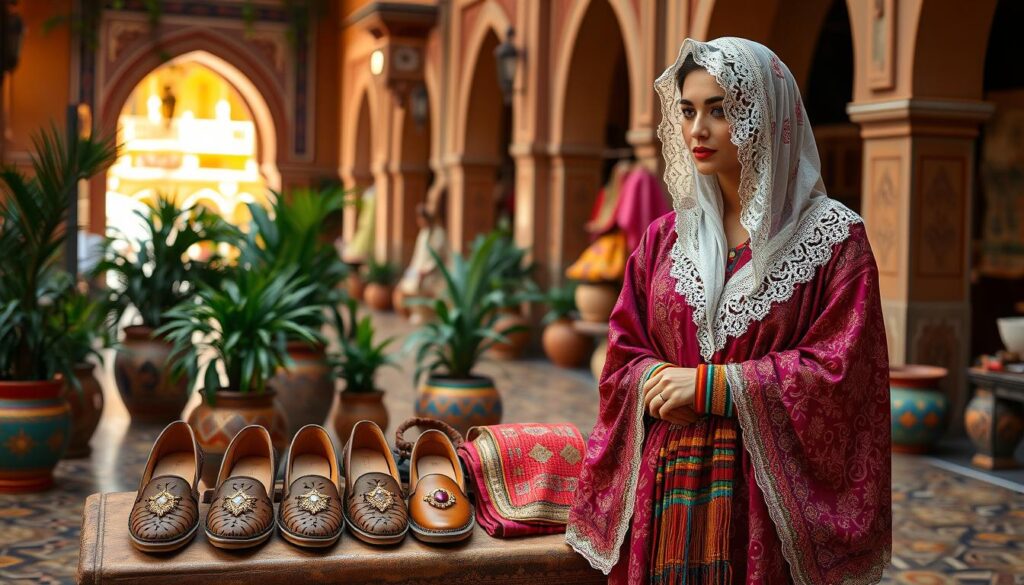
The Kaftan and Other Attire
The kaftan is a key piece of Moroccan Culture (clothing). It’s elegant and comfy. People wear it for both casual and formal events.
It comes in many styles and materials. You can find simple cotton for daily wear or fancy silk and embroidery for special times.
Other traditional clothes include the jellaba, a long, hooded cloak for warmth. And the takchita, a fancy, layered dress for weddings and big celebrations.
Modern Influences on Moroccan Fashion
Modern trends are changing Moroccan fashion. Designers mix old techniques with new styles. This creates a unique look that people love.
When you go to Marrakech, pack clothes that respect the Moroccan culture but also feel good. Bring essential items for Marrakech like light, modest clothes and comfy shoes. Also, follow packing tips for Marrakech to enjoy the city’s lively vibe.
Traditional and modern fashion blend in Morocco. This mix shows the country’s rich history and creativity. It’s what makes Moroccan fashion so interesting.
Architecture and Urban Planning
Moroccan architecture is a mix of many influences. It shows the country’s rich history and culture. You’ll see amazing buildings, like mosques and riads, as you wander through medinas and cities.
The Beauty of Moroccan Riads
A traditional riad is a key part of Moroccan design. It has a central courtyard and beautiful decor. The arches, domes, and zellij tile work make it stunning and peaceful.
When in Marrakech, don’t miss out on seeing these riads. A good camera is a Marrakech travel essential to capture their beauty.
Riads were once family homes, focusing on beauty inside rather than outside. Now, many are hotels, restaurants, and cultural spots. A guidebook is a must-have item for your Marrakech trip. It helps you understand the history and beauty of these places.
Famous Landmarks and Their Stories
Morocco has many famous landmarks with their own stories. The Koutoubia Mosque in Marrakech is a symbol of the city’s history and architecture. The Bahia Palace shows the best of Islamic craftsmanship, with its woodwork and tile decorations.
Visiting these landmarks lets you appreciate Moroccan culture more. For example, the El Badi Palace in Marrakech was once a grand palace. Now, its ruins show the past’s opulence.
Make sure to include these landmarks in your Marrakech trip plan. Having the right Marrakech travel essentials, like comfy shoes and a camera, will make your visit better.
Moroccan Hospitality and Social Customs
The warmth of Moroccan hospitality is something visitors often talk about long after they leave. As you explore Moroccan culture, you’ll find a culture that values generosity and welcoming nature. This makes you feel right at home.
Understanding Moroccan Etiquette
To fully appreciate Moroccan hospitality, it’s key to understand the local etiquette. When visiting Moroccan homes, it’s customary to bring a gift, like sweets or pastries, as a sign of respect. Greeting locals with a friendly “As-salamu alaykum” (peace be upon you) can also make a great impression.
When interacting with Moroccans, remember that politeness and courtesy are highly valued. Using your right hand when giving or receiving something is considered polite. This is because the left hand is associated with personal hygiene.
The Art of Moroccan Hospitality
Moroccan hospitality is famous for its warmth and generosity. Visitors are often treated to delicious meals and refreshing drinks, showing off the country’s rich culinary heritage. Participating in a traditional tea ceremony is a must, as it’s a key part of Moroccan social customs.
When invited to a Moroccan home, be ready to be treated like family. The locals take great pride in their hospitality. It’s not uncommon for guests to be showered with attention and affection.
To make the most of your experience in Morocco, consider adding a few thoughtful items to your Marrakech packing list. A gift for your host or a small token of appreciation can show your respect for the culture. It will also improve your interactions with the locals.
Conclusion: Embracing Moroccan Culture in Everyday Life
As you finish exploring Moroccan culture, you’ll appreciate its rich heritage more. Morocco offers vibrant markets and serene landscapes for every traveler.
When planning your next trip to Marrakech, think about what to pack. Include comfy clothes, sunscreen, and a camera for stunning views. Also, bring an open mind to enjoy the local culture.
By taking Moroccan Culture into your daily life, you can live more relaxed. You’ll appreciate traditional crafts and Moroccan food. Cooking, fashion, or admiring Moroccan architecture can bring Morocco into your day.
